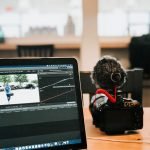Introduction.
Video content is everywhere, and it’s a big part of how we consume information, connect with others, and learn.
If you’re creating content for platforms like YouTube, Instagram, TikTok, or even a blog, knowing how to edit videos has become almost essential.
Good editing can transform an average clip into something eye-catching, engaging, and memorable.
So why does editing matter so much? First impressions are crucial, and video editing is your way of making sure people stick around.
A well-edited video can make the difference between someone watching all the way through or clicking away in seconds.
Plus, when you take the time to polish your video, you show viewers that you value their time, and they’ll likely trust your content more.
This guide will walk you through the basics of video editing for content creation, covering tools, tips, pros and cons of popular software, and some FAQs that might come up when you’re just getting started.
By the end, you’ll have a clearer idea of how to edit your videos for a more professional, polished look.
Why Editing is Important in Content Creation
Editing isn’t just about cutting out mistakes—it’s about telling a story. Your editing choices can set the tone, pace, and mood of the entire video. Here’s a quick breakdown of how good editing impacts your content:
- Improves Engagement: Engaging videos often have clean cuts, a good pace, and maybe a touch of music or effects. These elements hold viewers’ attention, making them more likely to watch until the end.
- Reflects Your Brand: Editing can reinforce your style and message. Consistent visuals, transitions, and colors make your videos recognizable and build your brand over time.
- Makes Content Shareable: A well-edited video is easier to watch and understand, increasing the chances that viewers will share it.
- Enhances Message Clarity: Editing helps you organize your thoughts so viewers can follow along easily, especially when you’re explaining something complex.
The Basics of Video Editing for Content Creation
Let’s start with some foundational aspects of video editing. Whether you’re using high-end software or a simple app, these basic steps will help you improve the quality of your content.
1. Trimming and Cutting.
The first step is to remove unnecessary parts from your video. Trim the beginning, end, and any awkward pauses. This is the easiest way to make sure your video stays focused and snappy.
2. Adding Transitions.
Transitions are great for smoothing out the shift between clips. Be mindful, though—overusing flashy transitions can distract from your content. Simple fades or cuts work best in most cases.
3. Including Text and Titles.
Adding text, titles, or subtitles can make your video more informative. For example, including an intro title with your name or social media handle at the beginning is helpful for branding.
4. Adjusting Color and Sound.
Colour correction and audio adjustments are where videos go from “good” to “great.” Try tweaking the brightness, contrast, and saturation to make sure your video looks polished and clear. For sound, ensure your voice is clear and any background music doesn’t overpower it.
5. Incorporating Effects and Music.
Light effects and background music can add personality to your video. Just remember that effects work best when they support your content, not distract from it.
Video Editing Software: Pros and Cons
Here’s a quick look at some popular video editing tools to help you decide which might work best for you.
1. iMovie
- Pros: Free (for Mac users), simple interface, basic editing tools.
- Cons: Limited advanced features, Mac-only.
- Best For: Beginners on Mac who need a quick and easy tool.
2. Adobe Premiere Pro
- Pros: Professional features, tons of customization options, widely used in the industry.
- Cons: Subscription-based, might have a steep learning curve.
- Best For: Intermediate to advanced users who want high-quality, professional edits.
3. Final Cut Pro
- Pros: Powerful editing tools, optimized for Mac, one-time purchase.
- Cons: Mac-only, can be expensive upfront.
- Best For: Mac users ready to invest in professional-grade software.
4. DaVinci Resolve
- Pros: Free version has great features, excellent color grading tools.
- Cons: High learning curve, requires a decent computer setup.
- Best For: Users looking for professional quality without a high cost.
5. CapCut (Mobile App)
- Pros: Free, easy to use, perfect for short-form content like TikToks.
- Cons: Limited features compared to desktop software, watermark in some versions.
- Best For: Beginners editing on mobile for social media platforms.
Tips for Better Video Editing
Here are a few editing tips that can take your videos to the next level:
- Stick to Your Style: Find a style that suits your brand or personality. For example, some creators use upbeat music and fast cuts, while others prefer a slower, more cinematic vibe.
- Keep an Eye on Audio Levels: Audio is often half the viewing experience. Make sure your audio levels are consistent so viewers don’t have to constantly adjust their volume.
- Experiment with Color: Adjusting colors can set the mood and make your video look more professional. Try warm tones for a cozy vibe or cooler tones for a techy look.
- Use Templates or Presets: Many editing programs come with templates that can save you time and make your video look polished. These can be particularly useful for intros, outros, and transitions.
FAQs
Q: Do I need a powerful computer for video editing?
Not necessarily. While more processing power helps with heavy tasks, many video editing apps (like iMovie or CapCut) work well on basic setups or even smartphones. However, if you plan on using software like Adobe Premiere Pro, a more powerful setup will be beneficial.
Q: How long does it take to edit a video?
Editing time depends on the length and complexity of the video. For simple social media clips, 10-20 minutes might be enough. For a more complex project, it could take hours or even days.
Q: Do I need to know a lot about technology to start editing?
Not really. There are plenty of beginner-friendly tools, and lots of free tutorials online. Starting with basic software like iMovie or CapCut can make the learning process smoother.
Q: What’s the best software for someone on a budget?
DaVinci Resolve offers a free version with a lot of features, so it’s a great choice if you’re looking for professional quality without spending money. CapCut and iMovie are also good options for beginners who want simple, budget-friendly editing tools.
Q: Should I use background music in my videos?
Background music can add energy and emotion, but keep it subtle. Make sure it’s not too loud, so it doesn’t overpower your voice. Also, be mindful of copyright; use royalty-free music or music you have permission to use.
Final Thoughts
Learning to edit videos can be a game-changer for anyone looking to make an impact online. It’s one of those skills that may seem intimidating at first, but with some practice and the right tools, it can become a natural part of your content creation process.
Editing allows you to tell your story more effectively, create a consistent look, and make your content more engaging.
Ready to start editing? What video editing software are you excited to try first, and how do you plan to use it to make your content stand out?





GIPHY App Key not set. Please check settings